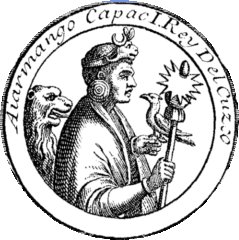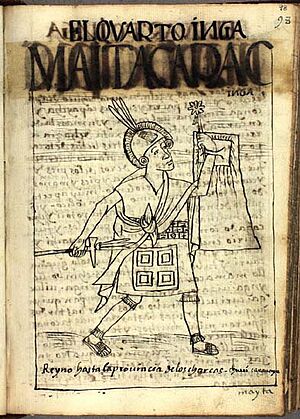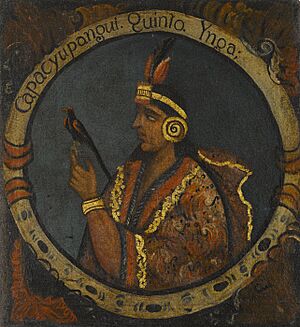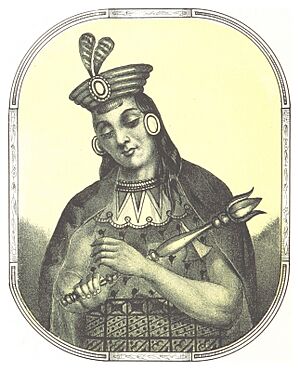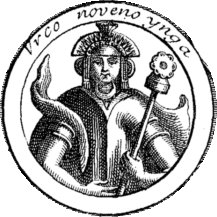Kingdom of Cusco facts for kids
Quick facts for kids
Kingdom of Cuzco
|
|||||||||||
|---|---|---|---|---|---|---|---|---|---|---|---|
| c. 1200–c. 1438 | |||||||||||
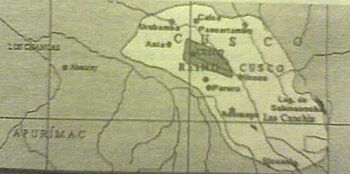
Map of the Kingdom of Cusco.
|
|||||||||||
| Capital | Cusco | ||||||||||
| Common languages | Quechua, Puquina | ||||||||||
| Religion | Inca religion | ||||||||||
| Government | Monarchy | ||||||||||
| Sapa Inca | |||||||||||
|
• c. 1200–1230
|
Manco Capac | ||||||||||
|
• c. 1230–1260
|
Sinchi Roca | ||||||||||
|
• c. 1260–1290
|
Lloque Yupanqui | ||||||||||
| Historical era | Pre-Columbian | ||||||||||
|
• Manco Capac organized the Kingdom of Cusco
|
c. 1200 | ||||||||||
|
• Inca Roca overthrows Capac Yupanqui and becomes the first Hanan Cusco ruler
|
c. 1350 | ||||||||||
|
• Cusi Yupanqui defeats the Chanka people
|
c. 1438 | ||||||||||
|
|||||||||||
| Today part of | Peru | ||||||||||
The Kingdom of Cusco (also spelled Cuzco) was a small kingdom in the Andes mountains. It started as a small city-state founded by the Incas around the early 1200s. Over time, through battles and peaceful agreements, it grew into the mighty Inca Empire (1438–1533). The city of Cusco was its capital.
Contents
How Cusco Was Governed
The way Cusco was governed was similar to other groups in the region. Early rulers were likely called Kuraka or sinchi. A Kuraka was the leader of an ayllu, which was a group of families connected by a common ancestor. These groups could be very different in size.
The word Capac meant "powerful" or "mighty." So, a Capac kuraka was a "Powerful lord" who led larger groups. The term Hatun kuraka ("Great lord") was similar and was used even during the later Inca Empire for leaders of big provinces.
A Sinchi was like a military leader or Warlord. This person was chosen by the most important members of an ayllu to defend their land or lead attacks. This role was usually temporary. However, because conflicts in the Andes could last a long time, a sinchi might act like a Kuraka during war.
Later, around the time of Inca Roca, rulers began to use the title Sapa Inca or simply Inca. This term later described the entire Inca people, but it also meant "monarch" or "emperor."
History of Cusco
The history of the Kingdom of Cusco is full of interesting stories and important leaders. It began with a journey and grew through the efforts of its early rulers.
How Cusco Began
The story of Cusco's beginning starts with a group of people who spoke the Puquina language. They were traveling from the falling Tiwanaku Empire near Lake Titicaca. They found a place called Paqariq Tampu, which was special to the Maras people. After living there for many years, the group split into two.
One group, the Tampus, eventually settled in Ollantaytambo. The second group, led by Manco Capac, came from a special "window" called Qhapaq t'uqu. This group included 10 ayllus (family groups). As they traveled, they often stopped for years to farm near other villages.
They stopped at Huanancancha, where Manco Capac took Mama Ocllo as his partner. Then they stopped at Tampuquiro, where Sinchi Roca might have been born. At Pallata, Sinchi Roca's first haircut was celebrated. They continued to Quirirmanta, where Manco Capac officially married Mama Ocllo. He also had other partners, including the strong Mama Huaco.
The Incas captured the Huanacauri area from the Alcahuisa people. They also took control of Matagua, where Sinchi Roca became an adult in a special ceremony. Finally, they planned to take control of the Huatanay river valley, which was home to many groups like the Huallas, Saños, and Alcahuisas.
To avoid a big fight, Manco Capac sought an alliance. He met with Sitichuaman, the leader of the Saños. They agreed to an alliance, and Sinchi Roca married Sitichuaman's daughter, Mama Coca.
The Huallas, led by Apu Cagua, decided to fight. But Mama Huaco led the Inca forces and defeated them completely. Many Huallas were removed from the area, and they fled towards the modern-day Sacred Valley of the Incas.
The Alcahuisas and Sahuaseras also fought hard but were defeated. The Alcahuisa chief, Copalimayta, chose to leave rather than be ruled. The Sahuaseras were sent south. The Poques were sent east, and the Lares were sent northwest. The Antasayas were moved to the edge of Cusco later. The new city of Cusco was divided into four areas: Quinticancha, Chumbicancha, Sairecancha, and Yarambuycancha.
Early Rulers: Hurin Cusco Dynasty
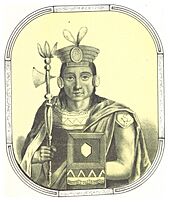
After Manco Capac passed away, Sinchi Roca (around 1230–1260) became the ruler of Cusco. His name means "Generous warlord," suggesting he was important in conquering the valley. However, he didn't expand Cusco's territory much during his rule. He built terraces and brought in a lot of soil to make the valley more fertile. He also had a conflict with the large Ayarmaca group. His family was known as the Raura panaca.
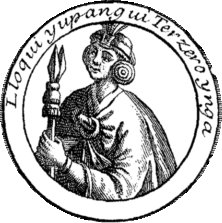
His son, Lloque Yupanqui (around 1260–1290), continued the conflict with the Ayarmaca. He took advantage of their leader's death to weaken them, which allowed him to conquer the land of the Maras people. Lloque Yupanqui was smart and kept good relationships with neighboring groups to protect his territory. He even made friends with some Ayarmaca groups, which caused problems within their larger group. He married Mama Cahua for political reasons, and his family was called the Auyni panaca.
When his father died, a young Mayta Capac (around 1290–1320) took charge. He was known for his great strength and bravery even as a child. During his rule, the Alcahuisa people tried to rebel. The conflict started over an incident at a well. Mayta Capac fought back bravely when his temple was attacked at night. The Incas won two battles, leading to a truce. When the rebels broke the truce, the Alcahuisa leader was captured and imprisoned. Their lands were then divided among the people of Cusco.
After this victory, many groups allied with Cusco. Mayta Capac planned to explore the Cunti region to the southwest but passed away from illness before he could leave. He married Mama Tancaray and had many children. His eldest son, Cunti Mayta, became a high priest. He chose another son, Tarco Huaman, as his successor.
Tarco Huaman ruled only for a short time before his cousin, Capac Yupanqui, removed him from power. Capac Yupanqui made sure his relatives would not challenge his rule. Tarco Huaman was later sent as a governor to collect tribute from a newly added group.
Capac Yupanqui (around 1320–1350) inherited a Cusco that was no longer a small group but a growing power. He continued his uncle's plan by invading the Cunti people, defeating them quickly. Because of his victory, the Quechua group (not the same as the Quechua people) asked for his protection against the expanding Chanka people. He agreed and sent them gifts. He also conquered other groups like the Masca and Anta. From the Cuyo group, he asked for bird cages as tribute, which were used in special ceremonies before battles.
The Ayarmaca group, having recovered from earlier conflicts, saw the Chanka as a bigger threat than Cusco. They allied with Capac Yupanqui by sending Princess Curi Hilpay for him to marry. They had a son named Quispe Yupanqui. Capac Yupanqui had another wife, Cusi Chimbo, who was known for being "cruel." She caused his death, leading to a political crisis in Cusco. The Chanka took advantage of this chaos and conquered the Quechua group. Capac Yupanqui named Quispe Yupanqui as his successor, but Quispe Yupanqui was killed during a quick change in government led by Inca Roca.
Later Rulers: Hanan Cusco Dynasty

Inca Roca (around 1350–1380) was the first ruler to use the title "Inka" for himself, meaning monarch or emperor. Before him, Cusco's leaders were usually called sinchis or curacas.
Because of the political problems in Cusco, some groups rebelled against the new government. The Mascas, who supported the old Hurin dynasty, rebelled but were defeated and their chief was jailed. The leaders of the Muyna and Pinagua groups also tried to become independent but failed.
After these events, Inca Roca led an expedition and conquered the town of Caytomarca, but he later lost it because he didn't leave soldiers behind. He also conquered the people of Pumatambo to the southwest.

The Chanka people were now close to invading Cusco and the Ayarmaca. Inca Roca surprised them with an attack, hiring soldiers from the Canas and Canchis groups. He made the Chankas flee back to Andahuaylas. Many years later, he led another expedition northeast to the Paucartambo River, conquering towns there. These were the first areas where the Incas grew coca plants.
One of the first things Inca Roca did was build a new palace in the Hanan (upper) part of the city. This started the tradition that each Sapa Inca would build their own official home. He improved Cusco by building canals for the Saphy and Tullumayo rivers, which still exist today. He also ordered young nobles to learn how to use weapons and quipus (knotted cords for record-keeping). Some say he founded the first school for Inca nobility, called a Yachaywasi.
Inca Roca married Mama Micay, who was the daughter of a local chief. She was once engaged to Tocay Capac, the leader of the Ayarmaca. When Tocay Capac heard about the marriage, he declared war. After some years, they agreed to peace if Inca Roca's young son, Titu Cusi Huallpa, was given to the Ayarmaca. The boy was tricked and kidnapped. Tocay Capac planned to kill him, but legend says when the boy cried, blood came from his eyes. This moved the chief, who spared his life.
Titu Cusi Huallpa stayed with the Ayarmaca for a year. Then, Chimor Orma, Tocay Capac's wife, helped him escape. They were chased but managed to get away. The boy was returned to Cusco, and the Antas, who helped him, were treated as brothers by Cusco. To end the fighting, Cusco and Ayarmaca exchanged women: Tocay Capac's daughter married Titu Cusi Huallpa, and Inca Roca's daughter married Tocay Capac. Inca Roca had many children, and his family was called the Vicaquirao panaca. His rule was one of the best and helped lay the foundation for the Inca Empire.
Titu Cusi Huallpa became ruler and took the name Yahuar Huaca (around 1380–1400), which means "The one who cries blood." This name remembered the legend from his childhood. Early in his rule, he had to stop another rebellion by the Muyna and Pinagua groups. He realized they needed to leave soldiers in conquered areas to prevent future uprisings. He then conquered about 10 more groups near Cusco.
During his rule, there were no problems with the Ayarmacas because of his marriage to Mama Chiquia, who became his main wife. They had two sons, Paucar Ayllu and Pahuac Huallpa Mayta. Pahuac Huallpa Mayta became his successor, even though he was the younger son. This upset the Huallacan group, who wanted their relative to be the next ruler. They planned to ambush the young prince, and both he and his bodyguards were killed.
Yahuar Huaca ordered the town of Paulo to be destroyed, and many people were removed from the area. After this sad event, he prepared his army for an expedition. However, the Cunti people rebelled during a party in Cusco. They attacked Yahuar Huaca, who tried to find safety but was killed. The rebels stopped their attack because of a sudden thunderstorm, believing it was a sign from the gods. They returned to their lands.

The death of Yahuar Huaca caused chaos in Cusco. The Chanka took back the Apurímac River area. With no clear leader, the remaining noble families met to decide what to do. A woman suggested Hatun Tupac, a nephew of the former ruler. He was chosen and took the name Viracocha Inca (around 1400–1438), supposedly after a dream where the god Viracocha appeared. This also helped make his rule seem more legitimate. His coronation was attended by leaders from all over.
The new Sapa Inca married Mama Runtu, but she was shy and didn't have much influence. He favored another wife, Curi Chulpi, who was the mother of his favorite son, Inca Urco.
Viracocha Inca conquered the valleys of Yucay and Calca. He also put down a small rebellion in the Pisac valley. This uprising led to more attacks from other groups, but they were all defeated by Viracocha's military leaders.
The people of Caytomarca also rebelled, saying they didn't fear the Sapa Inca. They fortified themselves by the Urubamba River. During a battle, Viracocha used a clever trick: he launched a heated stone that set a house on fire. An old woman claimed it fell from the sky, making the people believe it was a divine sign. Fearing defeat, they surrendered. Viracocha pretended to be uninterested but then told them he would have defeated them anyway. They made a peace agreement.
While Viracocha was away, a relative of Yahuar Huaca tried to take power in Cusco but failed and took his own life. Viracocha then made sure to appoint loyal high priests. He also wanted to destroy old idols, but Mama Runtu stopped him, saying it would break the laws of their ancestors.
Once order was restored, Viracocha focused on building new homes, increasing farms, and making textiles. These products were important for rewarding his warriors and servants.
During this time, the Lupaca chiefdom and the Colla Kingdom were strong rivals. They both sought an alliance with the Incas. Viracocha promised support to both, but secretly helped the Lupacas. On his way south, Viracocha conquered the Canchis group easily. The Canas group joined peacefully. He ordered a temple built for the god Viracocha and arranged for them to provide supplies.
The leader of the Collas learned of the secret alliance and attacked the Lupacas before the Incas arrived. The Lupaca leader won the battle. Viracocha quickly went to meet the Lupaca leader. They swore eternal peace by sharing a special cup of chicha.
When Viracocha returned to Cusco, he wanted to retire and name Inca Urco as his successor. Inca Urco began a period of fasting and rituals. On the special day, he appeared with the crown and held big celebrations.
However, Inca Urco's short rule was very bad for Cusco. He didn't build anything and was not a good warrior. Many nobles were unhappy and wanted to remove him from power. But they feared Viracocha's anger, as he still supported his favorite son.
|


